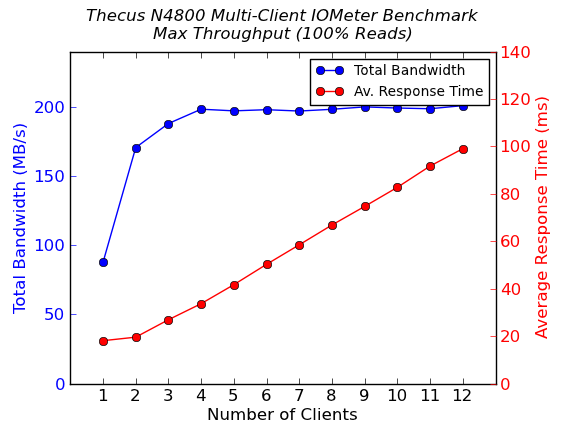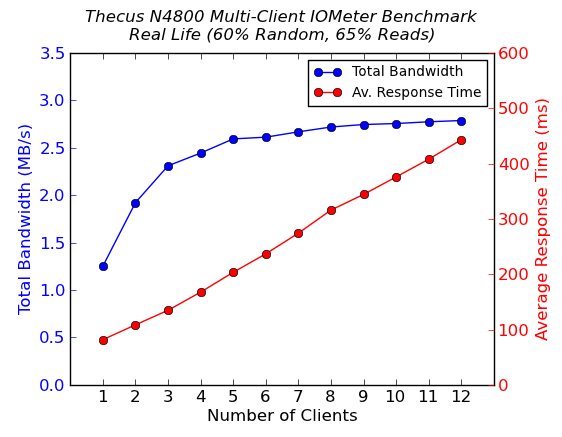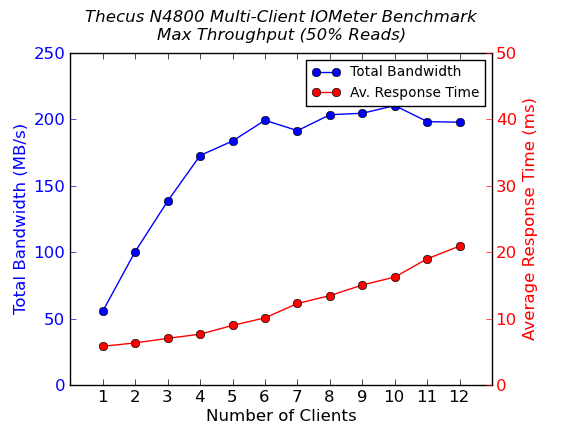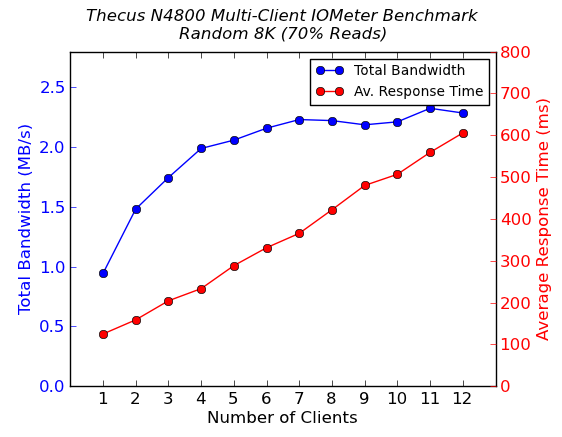Building the 2012 AnandTech SMB / SOHO NAS Testbed
by Ganesh T S on September 5, 2012 6:00 PM EST- Posted in
- IT Computing
- Storage
- NAS
Testbed in Action : Thecus N4800
We have been evaluating the Thecus N4800, a 4-bay NAS unit based on the Atom D2700, over the last couple of months. A full length detailed review is forthcoming, but we'll take this opportunity to present the results of the newly added test suite components for the N4800 with four disks in RAID5. The following four graphs show the total available bandwidth and the average response time while being subject to different types of workloads through IOMeter. IOMeter also reports various other metrics of interest such as maximum response time, read and write IOPS, separate read and write bandwidth figures etc. Selected metrics from the evaluation of the Thecus N4800 are available here.




The full power of dual LAN ports with link aggregation is seen in these results, particularly for the 100% sequential read and 50% sequential read / 50% sequential write case. In the latter, we are able to hit as much as 210 MBps with ten clients active. The Thecus N4800 seems to hold up much better when compared to the Synology DS211+ as the number of clients increases. With just twelve simultaneous clients, we don't see a marked decrease in performance at any given node, unlike what we saw with the Synology DS211+ in the previous section. However, this is only to be expected because of the hardware configuration.










74 Comments
View All Comments
Zarquan - Thursday, September 6, 2012 - link
I might be missing something really obvious here .. but if the highest power consumption was 146.7 W (IOMeter 100% Seq 100% Reads [ 12 VMs ]), then why did you need a 850W power supply ?Either the system is using a lot more than the 146.7 W you quoted in your power consumption figures, or the power supply is way over specified.
http://www.anandtech.com/show/6241/building-the-20...
ganeshts - Thursday, September 6, 2012 - link
This is not the only workload we plan to run on the machine.We were ready to put up with some inefficiency just to make sure we didn't have to open up the machine and put in a more powerful PSU down the road. The 850W PSU should serve the testbed well for future workloads which might be more stressful.
ydafff - Thursday, September 6, 2012 - link
I’m VCP:5 / 4 and MCSE and MCITP:VA / EAThis setup for 12 VMs way overkill..
Best for this test bad will be VMware vSphere Hypervisor( Free ESXi) – much better memory and vCPU and storage management or MS Hyper-V 2008 R2 free server - try to use free Hyper-V 2008 server much less HD space and compute resources needed
Regarding VMs density you could easy run all 12 VMs(1-2 GB memory) from single Sandy Bridge-E CPU or 1155 Xeon(i7) CPU with really good performance. Storage 2x intel 320 series 600GB SSD in RAID 1(you will need Redundancy) with thin provisioning will do trick.
ganeshts - Thursday, September 6, 2012 - link
ydaff, Thanks for the inputs.We are working towards increasing the VM density in the current testbed itself. As another reader pointed out, 12 VMs were not enough to stress the Thecus N4800.
I decided not go with the Hyper-V 2008 R2 free server because I needed to run some programs / scripts in the host OS and the Z9PE-D8 WS had drivers specifically for Win Server 2008 R2.
eanazag - Thursday, September 6, 2012 - link
Seems like a lot of people are talking about it being over the top. I agree with the route Anandtech took - could have even went farther. How far can they be pushed is my question? I want to see when they start smoking NAS's. The article and concept is great. I like to know how the site sets up its test scenarios and equipment. It lets me know if my use case is higher or lower and what the device being reviewd can do. I look at your testing methods to decide if your data is worth considering. I continue to be an avid reader here because of the effort placed. If you had one PC with one NIC, anyone in their house can test it like that. Why even write reviews about NAS's if that is how far you are going to test? Great job, Anandtech.I have some applications at work I would like to create repeatable tests for. An article about how to automate applications for testing would be helpful. I saw that we got a little in this article. I would also like to see more enterprise equipment being tested if you can swing it.
KingHerod - Friday, September 7, 2012 - link
NAS devices are convenient and generally low-power, but it would be nice to see a comparison to some real metal with a real server OS like Server 2k8R2. Maybe a repurposed older computer with a couple drives mirrored and an actual, low end server with some SAS drives.dbarth1409 - Friday, September 7, 2012 - link
Ganesh,Good work. I'm looking forward to seeing some future test results.
dijuremo - Monday, September 10, 2012 - link
This asus motherboard is not truly ACPI compliant, ASUS knows it and they do not want to fix it. Their tech support has given stupid excuses to posts from users trying to run Windows 8 and 2012 server on it.If you boot either Windows 8 or 2012 server RTM on it, it blue screens with error:
0xA5: ACPI_BIOS_ERROR
You just need to check the reviews at the egg to confirm.
http://www.newegg.com/Product/Product.aspx?Item=N8...
ganeshts - Monday, September 10, 2012 - link
Looks like Asus has updated support files for Windows 8.VTArbyP - Monday, September 10, 2012 - link
I wonder what would happen if you did use Linux for the host and VM oses? I suppose that would become a test of Linux vs Windows! Heh.More seriously, why not add at least one VM of "the current popular distro" of Linux and and a Mac OS X machine Use them with NTFS drivers and / or reformat a NAS partition to native ext# and another to HFS+. Point being, how does the NAS react to mixed client loads and not all smb, as someone commented above. The other test this beast seems ideal for is comparisons of several non-local storage solutions - someone mentioned iSCSI, and I can imagine tryiing some types of SANs - might add an infiniband adapter - being of interest. The point of that would simply be to see what form of non-local storage was fastest, best value, easiest to maintain, etc, etc for us mortals who want to connect 6 - 12 machines, We, being the folks who DON'T run lans for a living and are not up to speed on what IT people already know